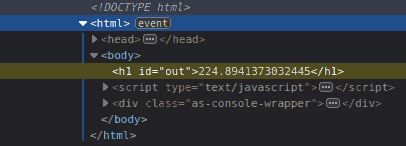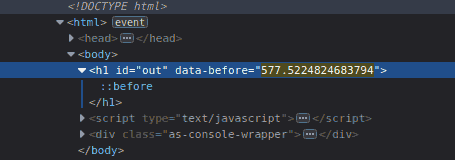How can I animate the drawing of text on a web page?
JavascriptCssCanvasHtml5 CanvasCss ShapesJavascript Problem Overview
I want to have a web page which has one centered word.
I want this word to be drawn with an animation, such that the page "writes" the word out the same way that we would, i.e. it starts at one point and draws lines and curves over time such that the end result is a glyph.
I do not care if this is done with <canvas> or the DOM, and I don't care whether it's done with JavaScript or CSS. The absence of jQuery would be nice, but not required.
How can I do this? I've searched exhaustively with no luck.
Javascript Solutions
Solution 1 - Javascript
> I want this word to be drawn with an animation, such that the page > "writes" the word out the same way that we would
##Canvas version
This will draw single chars more like one would write by hand. It uses a long dash-pattern where the on/off order is swapped over time per char. It also has a speed parameter.

Example animation (see demo below)
To increase realism and the organic feel, I added random letter-spacing, an y delta offset, transparency, a very subtle rotation and finally using an already "handwritten" font. These can be wrapped up as dynamic parameters to provide a broad range of "writing styles".
For a even more realistic look the path data would be required which it isn't by default. But this is a short and efficient piece of code which approximates hand-written behavior, and easy to implement.
##How it works
By defining a dash pattern we can create marching ants, dotted lines and so forth. Taking advantage of this by defining a very long dot for the "off" dot and gradually increase the "on" dot, it will give the illusion of drawing the line on when stroked while animating the dot length.
Since the off dot is so long the repeating pattern won't be visible (the length will vary with the size and characteristics of the typeface being used). The path of the letter will have a length so we need to make sure we are having each dot at least covering this length.
For letters that consists of more than one path (f.ex. O, R, P etc.) as one is for the outline, one is for the hollow part, the lines will appear to be drawn simultaneously. We can't do much about that with this technique as it would require access to each path segment to be stroked separately.
##Compatibility
For browsers that don't support the canvas element an alternative way to show the text can be placed between the tags, for example a styled text:
<canvas ...>
<div class="txtStyle">STROKE-ON CANVAS</div>
</canvas>
##Demo
This produces the live animated stroke-on (no dependencies) -
var ctx = document.querySelector("canvas").getContext("2d"),
dashLen = 220, dashOffset = dashLen, speed = 5,
txt = "STROKE-ON CANVAS", x = 30, i = 0;
ctx.font = "50px Comic Sans MS, cursive, TSCu_Comic, sans-serif";
ctx.lineWidth = 5; ctx.lineJoin = "round"; ctx.globalAlpha = 2/3;
ctx.strokeStyle = ctx.fillStyle = "#1f2f90";
(function loop() {
ctx.clearRect(x, 0, 60, 150);
ctx.setLineDash([dashLen - dashOffset, dashOffset - speed]); // create a long dash mask
dashOffset -= speed; // reduce dash length
ctx.strokeText(txt[i], x, 90); // stroke letter
if (dashOffset > 0) requestAnimationFrame(loop); // animate
else {
ctx.fillText(txt[i], x, 90); // fill final letter
dashOffset = dashLen; // prep next char
x += ctx.measureText(txt[i++]).width + ctx.lineWidth * Math.random();
ctx.setTransform(1, 0, 0, 1, 0, 3 * Math.random()); // random y-delta
ctx.rotate(Math.random() * 0.005); // random rotation
if (i < txt.length) requestAnimationFrame(loop);
}
})();
canvas {background:url(http://i.imgur.com/5RIXWIE.png)}
<canvas width=630></canvas>
Solution 2 - Javascript
Edit 2019
I created a javascript library that can create realistic animations. It's easy to use and requires a special JSON file that acts as font.
var vara = new Vara("#container", "https://rawcdn.githack.com/akzhy/Vara/ed6ab92fdf196596266ae76867c415fa659eb348/fonts/Satisfy/SatisfySL.json", [{
text: "Hello World!!",
fontSize: 48,
y:10
}, {
text: "Realistic Animations",
fontSize: 34,
color:"#f44336"
}], {
strokeWidth: 2,
textAlign:"center"
});
#container {
padding: 30px;
}
<script src="https://rawcdn.githack.com/akzhy/Vara/16e30acca2872212e28735cfdbaba696a355c780/src/vara.min.js"></script>
<div id="container"></div>
Checkout the Github page for documentation and examples. And Codepen
Previous Answer
The below example uses snap.js to dynamically create tspan elements and then animate each of their stroke-dashoffset.
var s = Snap('svg');
var text = 'Some Long Text'
var len = text.length;
var array = [];
for (var x = 0; x < len; x++) {
var t = text[x]
array.push(t);
}
var txt = s.text(50, 50, array)
$('tspan').css({
'font-size': 50,
fill: 'none',
stroke: 'red',
"stroke-width":2,
'stroke-dasharray': 300,
'stroke-dashoffset': 300
})
$('tspan').each(function(index) {
$(this).stop(true, true).delay(300 * index).animate({
'stroke-dashoffset': 0,
}, 300, function() {
$(this).css('fill', 'red')
})
})
<script src="https://cdnjs.cloudflare.com/ajax/libs/snap.svg/0.3.0/snap.svg-min.js"></script>
<script src="https://ajax.googleapis.com/ajax/libs/jquery/2.1.1/jquery.min.js"></script>
<svg width="500" height="500">
</svg>
Previous Answer
You can do something like this using svg's stroke-dasharray
text {
stroke-dasharray: 1000;
stroke-dashoffset: 1000;
-webkit-animation: draw 8s forwards;
}
@-webkit-keyframes draw {
100% {
stroke-dashoffset: 0;
}
}
text {
stroke-dasharray: 1000;
stroke-dashoffset: 1000;
-webkit-animation: draw 8s forwards;
-moz-animation: draw 8s forwards;
-o-animation: draw 8s forwards;
-ms-animation: draw 8s forwards;
animation: draw 8s forwards;
}
@-webkit-keyframes draw {
100% {
stroke-dashoffset: 0;
}
}
@-moz-keyframes draw {
100% {
stroke-dashoffset: 0;
}
}
@-o-keyframes draw {
100% {
stroke-dashoffset: 0;
}
}
@-ms-keyframes draw {
100% {
stroke-dashoffset: 0;
}
}
@keyframes draw {
100% {
stroke-dashoffset: 0;
}
}
<svg width="500" height="500">
<text x="100" y="80" fill="none" stroke="black" stroke-width="1" font-size="50">Some text</text>
</svg>
Without keyframes animation you can do something like this
<svg width="500" height="500">
<text x="100" y="80" fill="none" stroke="black" stroke-width="5" font-size="50" stroke-dasharray="1000"
stroke-dashoffset="1000">Some text
<animate attributeName="stroke-dashoffset"
from="1000"
to="0"
dur="8s"
fill="freeze">
</animate> </text>
</svg>
And for IE support you can use jquery/javascript
$('text').animate({
'stroke-dashoffset':'0'
},8000)
text {
stroke-dasharray: 1000;
stroke-dashoffset: 1000;
}
<script src="https://ajax.googleapis.com/ajax/libs/jquery/2.1.1/jquery.min.js"></script>
<svg width="500" height="500">
<text x="100" y="80" fill="none" stroke="black" stroke-width="1" font-size="50"
>Some text
</text>
</svg>
Solution 3 - Javascript
Only CSS :
@keyframes fadein_left {
from {
left: 0;
}
to {
left: 100%;
}
}
#start:before {
content: '';
position: absolute;
top: 0;
left: 0;
right: 0%;
opacity: 0.7;
height: 25px;
background: #fff;
animation: fadein_left 3s;
}
<div id="start">
some text some text some text some text some text
</div>
Solution 4 - Javascript
Following many tests, here is some notes. The goal is to display fast text data in the least blocking way, on DOM heavy pages requiring users interactions.
There is of course many ways to achieve the same thing. On this example, the differences might not be obvious, it really apply to complex interfaces.
Slowest: innerHTML and inline styling. The DOM is recalculated at each iterations. The browser is working hard to keep the train. It will fails quickly, causing memory leaks and freezes:
setInterval(function(){
out.innerHTML = `<span style="position:fixed;top:${~~(Math.random() * 220)}px">${Math.random() * 1000}<span>`
},1)
<h1 id="out"></h1>
Way better: Using textContent, requestAnimationFrame and the web animation api. This goes way smoother, it's obvious on DOM heavy pages. The user interactions won't blocks the repaints. Some repaints might be skipped, to keep the interface well responsive.
let job
const paint = () => {
job = requestAnimationFrame(paint)
out.textContent = Math.random() * 1000
out.animate([{top: ~~(Math.random() * 220)+"px"},{top:0}],{duration: 1,iterations: 1})
}
/* Start looping -----------------------------------------*/
requestAnimationFrame(paint)
#out{
position: fixed}
<h1 id="out"></h1>
On the above example, the DOM is still being recalculated for the text overflow.. We can see the debugger blinking hard. This really matter on cascading elements! This can still slows down javascript and user scrollings.
Full power: It's possible to use css alone to refresh the data with the css content rule and css variables. The text won't then be selectable.
let job
const paint = () => {
job = requestAnimationFrame(paint)
out.setAttribute('data-before', Math.random() * 1000)
out.animate([{top: ~~(Math.random() * 220)+"px"},{top:0}],{duration: 1,iterations: 1})
}
/* Start looping -----------------------------------------*/
requestAnimationFrame(paint)
#out{
position: fixed
}
#out:before {
content: attr(data-before)
}
<h1 id="out"></h1>
My tests showns great improvements, the javascript engine is skipping quickly on other tasks. Sometimes it can starts a bit slower than the above example. But beside that,this doesn't blocks users scrolls, and the debugger is also liking, no more jumpings.

